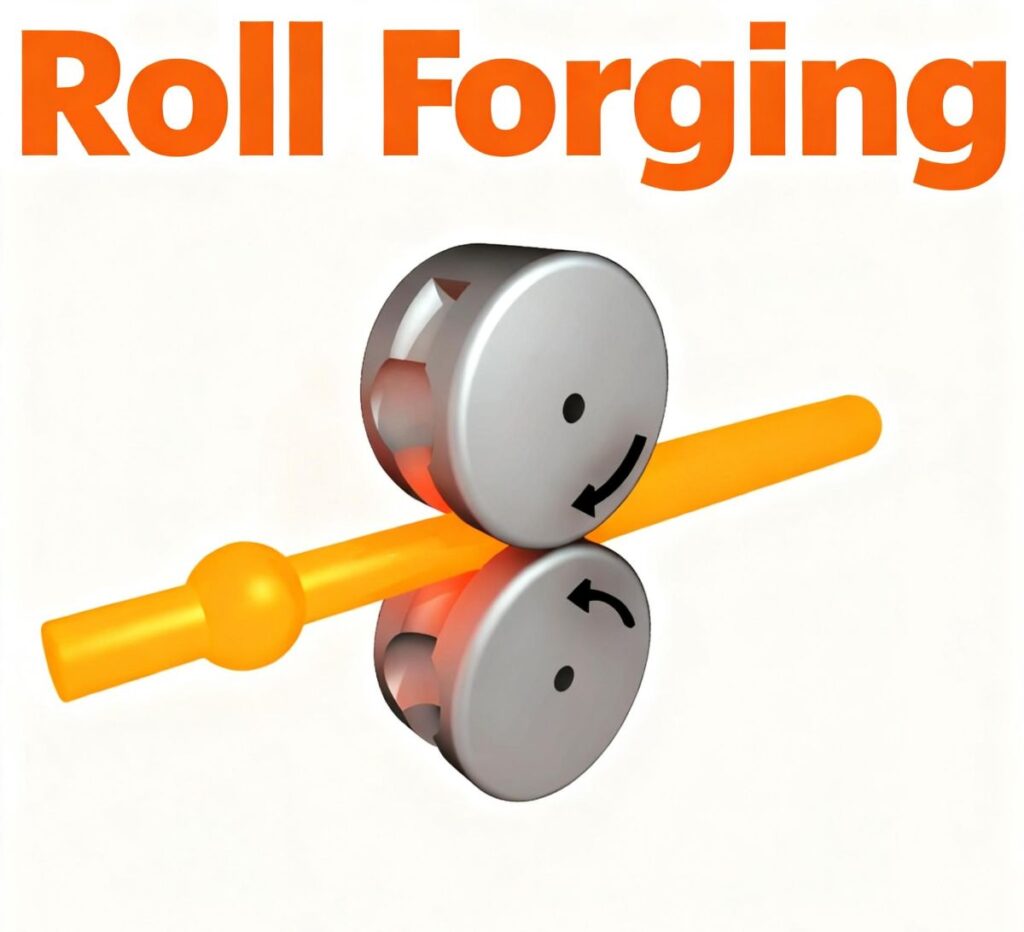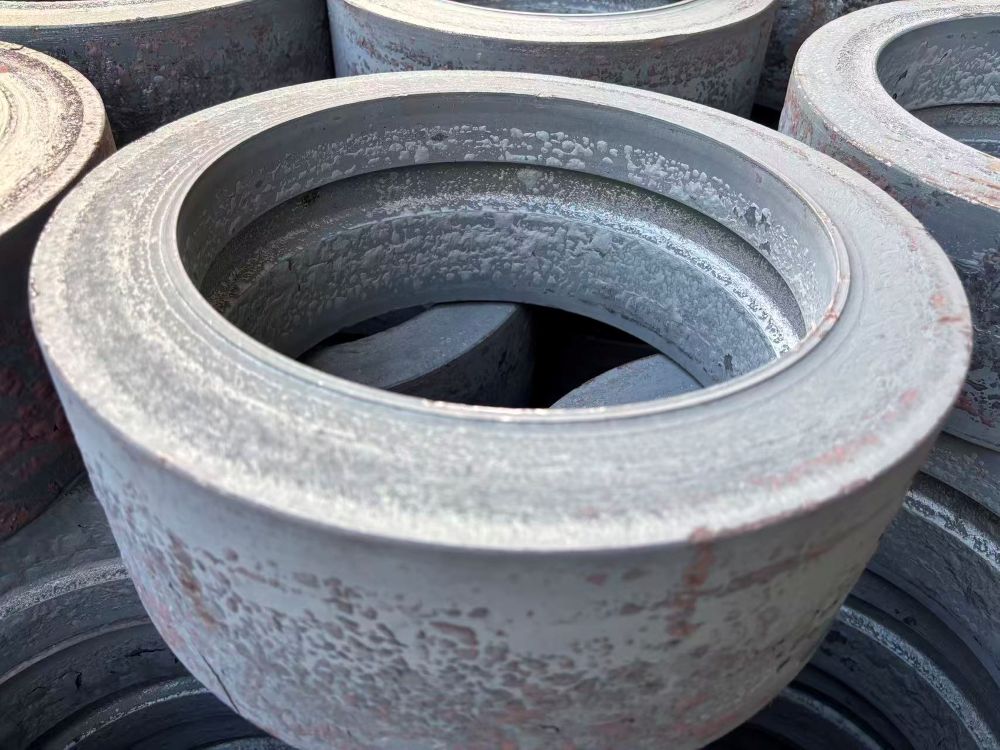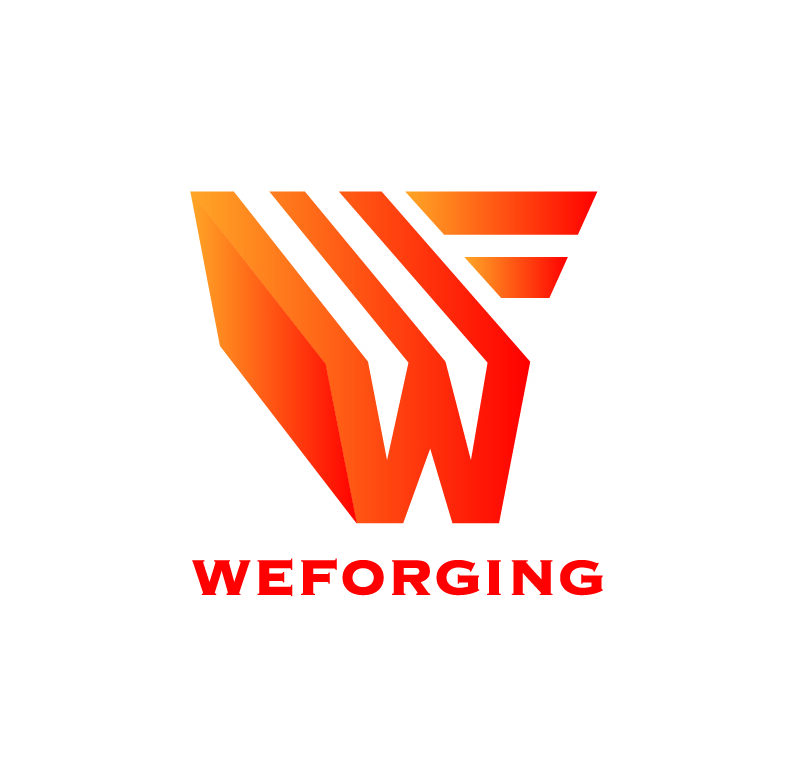What Is Roll Forging?
Introduction
Roll forging is a precision metal forming process that shapes heated billets between rotating rolls to produce uniform, high-strength components.It refines the grain structure, enhances fatigue resistance, and ensures dimensional accuracy.Compared with hammer or press forging, roll forging offers higher efficiency and consistent quality, making it widely used for shafts, gears, and flanges.
This article introduces the roll forging process, its main advantages, and typical industrial applications, showing why it remains a reliable solution for high-performance forged parts.

What Is Roll Forging?
Roll forging is a semi-continuous metal forming process where a preheated billet passes through grooved rolls.Each rotation compresses and elongates the billet, progressively forming the desired profile while refining the metal flow direction.The result is a part with excellent tensile strength, uniform density, and smooth surface finish.Compared to closed die forging, it requires less tooling investment and provides greater efficiency, making it ideal for shafts, gears, and flanges.Roll forging bridges the gap between open die flexibility and closed die precision, offering the optimal balance of accuracy, strength, and cost-effectiveness.

Roll Forging Process Explained
The roll forging process typically involves six key stages:
- Material Selection — Choose high-grade alloy, carbon, or stainless steel based on required mechanical performance.
- Heating — Billets are heated to 1050–1150°C for optimal plasticity and grain flow.
- Rolling Stage — The billet is shaped progressively between multiple rolls; deformation is distributed evenly to avoid internal defects.
- Heat Treatment — Controlled tempering or quenching enhances hardness, ductility, and fatigue strength.
- CNC Machining — Finishing processes ensure tolerance within ±0.01 mm and surface roughness Ra ≤ 1.6 µm.
- Testing — Each batch undergoes UT, MPI, hardness, and CMM dimensional testing in Weforging’s lab.
This combination of forging and CNC control delivers consistent microstructure, minimal residual stress, and superior repeatability.
Common Materials Used in Roll Forging
Material selection is a key factor in the roll forging process, directly affecting the mechanical performance and durability of forged parts.
Commonly used materials include :
- Carbon Steel:
Grades such as C45, 1045, and 45# are widely used for shafts, flanges, and gear blanks.They offer excellent forgeability, wide temperature range, and good cost-performance balance. - Alloy Steel:
42CrMo, 4140, SCM440, and similar grades are the most representative roll forging alloys.They provide high tensile strength, superior fatigue resistance, and stable microstructure — ideal for critical components like connecting rods, axles, and gears. - Stainless Steel:
Grades like 304, 316L, 420 are chosen for corrosion- and heat-resistant applications such as valve bodies, pump shafts, and marine fittings. - Aluminum & Copper Alloys:
Used for lightweight or conductive parts — for example, Al 6061, Al 7075, or Cu C11000 — offering excellent machinability and surface finish in aerospace and electrical applications.
Each material is selected according to strength requirements, service environment, and post-forging treatment.
Comparison Between Roll Forging and Other Forging Methods
Forging Method | Process Characteristics | Typical Applications | Key Advantages |
Roll Forging | Heated billet gradually shaped between rotating rolls. | Shafts, flanges, gear blanks. | High efficiency, fine grain flow, cost-effective. |
Free deformation between flat dies. | Large shafts, rings, heavy equipment. | Flexible for large parts, good mechanical properties. | |
Metal pressed into precision dies under high pressure. | Complex, high-precision components. | High dimensional accuracy, repeatability. | |
Press Forging | Slow, controlled pressing with high force. | Heavy-duty structural components. | Dense structure, stable mechanical behavior. |
Common Products Made by Roll Forging
Roll forging is ideal for components requiring high strength, accuracy, and load-bearing performance, such as:
- Transmission Shafts:Provide stable torque and fatigue resistance in automotive systems.
- Gear Blanks:Ensure concentricity and precision during gear cutting.
- Flanges & Rings: Used in wind turbines, petrochemical pipelines, and marine systems.
- Couplings & Pins: Deliver mechanical stability under impact and rotation.
- Bearing Races:Support rotational accuracy and extended lifespan.

Advantages of Roll Forging
The advantages of roll forging go far beyond production efficiency. Each benefit contributes to stronger materials, lower costs, and stable performance.
1️⃣ Optimized Material Utilization – The gradual deformation between rolls achieves up to 90% efficiency, reducing waste and machining time.
2️⃣ Refined Grain Flow and Strength – Continuous rolling aligns the metal grain along the load path, improving tensile and fatigue resistance.
3️⃣ Dimensional Stability and Repeatability – Controlled deformation and CNC finishing ensure precise geometry and consistent tolerances in every batch.
4️⃣ Cost and Energy Efficiency – Moreover, roll forging uses less energy than press forging while maintaining high throughput for mass production.
5️⃣ Enhanced Sustainability – In addition, the process minimizes scrap and supports sustainable manufacturing through efficient heat and material control.
Applications of Roll Forging
In industrial procurement, roll forging is valued for its balance of strength, precision, and cost-efficiency.It is mainly applied to rotational and load-bearing components that require uniform metal flow and high dimensional stability:
- Slewing Bearings & Gear Rings:
Roll forging ensures dense structure and smooth grain flow for bearing races, inner and outer rings, and large gear rings.
These parts operate under heavy axial and radial loads, where stability and fatigue life are critical purchasing concerns. - Flanges& Couplings:
Used in wind turbine hubs, transmission systems, and hydraulic assemblies — where forged flanges must maintain sealing integrity and consistent torque transfer under long-term stress. - Drive Shafts & Pinions:
For mechanical power transmission, roll forged shafts and pinions offer precise geometry, reducing post-machining costs and improving long-term alignment accuracy. - Heavy-Duty Rotational Components:
Applied in industrial turntables, excavators, and construction machinery, where forged profiles provide higher load capacity and lower risk of deformation.
Conclusion
Roll forging remains essential in modern manufacturing, combining controlled deformation, precision machining, and testing to produce components with long-term strength and stability.From automotive shafts to wind turbine flanges and gear blanks, roll forged parts ensure reliable performance across demanding applications.
At Weforging, we deliver complete solutions integrating forging, CNC machining, heat treatment, and inspection under ISO and AGMA standards.If you are looking for a trusted roll forging partner, send us your drawings or specifications. Our engineers will provide technical support and quotations promptly.
Contact Weforging to start your custom roll forging project.
F.A.Q.
Unlike open or closed die forging, roll forging gradually shapes heated billets between rotating rolls.This continuous deformation refines grain flow, improves fatigue strength, and ensures better dimensional stability with less material waste.
Roll forging delivers high material utilization (up to 90%), uniform mechanical properties, and excellent repeatability across batches.It is especially suited for shafts, gears, and flanges, where strength, precision, and efficiency are critical for OEM applications.
Roll forged components are widely applied in automotive, wind energy, aerospace, railway, and petrochemical industries.They are used in transmission shafts, bearing rings, turbine flanges, and other high-load structural parts requiring durability and precision.

